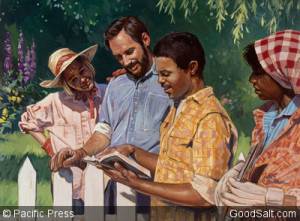Personal Evangelism and Witnessing Made Easy
If “one truth received into the heart will make room for still another truth,” 1 we wonder in what sequence the truths we hold should be presented in order to be most effective in our outreach. Our Sabbath School lesson on “Personal Evangelism and Witnessing” also asks, “Why should Christ’s substitutionary death always be at the forefront of all that we teach?”
I would like to deal with the last question first by sharing a passage from the book Gospel Workers which has made the greatest impact on the way I do my ministry.
The sacrifice of Christ as an atonement for sin is the great truth around which all other truths cluster. In order to be rightly understood and appreciated, every truth in the Word of God, from Genesis to Revelation, must be studied in the light that streams from the cross of Calvary. I present before you the great, grand monument of mercy and regeneration, salvation and redemption–the Son of God uplifted on the cross. This is to be the foundation of every discourse given by our ministers. (Ellen G. White, Gospel Workers, p. 315)
We are not saved by doctrines. We are saved by God’s grace. God reveals His love in each and every doctrine, in hopes that we will love Him too. Satan tries to skew Bible doctrine in hopes of skewing our concept of God’s love and thus make us not want to accept Him. This idea is what motivated me a few years ago to design the “In Light of The Cross” Bible study guides, which illustrate the love of God, and the cross in each doctrine, which is particularly relevant to Seventh-day Adventists. They are available free online in both English and Spanish. My passion is to promote the cross of Christ in everything I do.
Now to answer the first question, about in what sequences certain truths should be presented. Speaking from personal experience over the years, when giving a series of personal or group Bible studies, I always begin with the Gospel Presentation. I want people to make a decision to accept Jesus into their lives and have the hope of eternal life. The second presentation I give is on the Bible. At the end of this study I ask people to go by the Bible and the Bible only. This way, if someone later says they don’t have to follow a Bible teaching, because their pastor or friend said it was not important anymore, I remind them they made a decision to go by the Bible and not by what their friends say. The third study I do is on Love and Obedience, or trusting and obeying. In this study I ask people to make a decision to follow the Bible because we love Jesus. This way, if people later say they don’t have to follow a certain Bible teaching because “it’s not a salvation issue,” I remind them that the reason we obey the Bible is because we love Jesus, and not just to get to heaven. After those three studies, my sequence of Bible truth is based on each particular person and what is relevant to them.
In each study I want to encourage my Bible student in their personal relationship with Jesus. I am not looking for a quick baptism to make my numbers look good. Frankly it is not about me. I want to encourage my Bible student in a personal relationship with Jesus. The purpose of my personal and group Bible studies is to be relational. A foreign missionary now pastoring in Tennessee once told me, “Small groups don’t work in America, because we are more concerned about being right then we are about being relational.” I knew exactly what he was talking about. With exceptions, a lot of American evangelism has been little more than telling people “I’m right you’re wrong!” That is not how Jesus won the hearts of people.
Jesus saw in every soul one to whom must be given the call to His kingdom. He reached the hearts of the people by going among them as one who desired their good. He sought them in the public streets, in private houses, on the boats, in the synagogue, by the shores of the lake, and at the marriage feast. He met them at their daily vocations, and manifested an interest in their secular affairs. He carried His instruction into the household, bringing families in their own homes under the influence of His divine presence. His strong personal sympathy helped to win hearts. He often repaired to the mountains for solitary prayer, but this was a preparation for His labor among men in active life. From these seasons He came forth to relieve the sick, to instruct the ignorant, and to break the chains from the captives of Satan. It was by personal contact and association that Jesus trained His disciples. (Ellen White, Desire of Ages, p. 151)
I am not downplaying being right. Jesus was always right, but He was also always relational. His agenda was to meet the needs of the people and not use them as pawns and numbers in meeting the goals and expectations of the church. Jesus did not call me to be a car salesman, pressuring people to “buy” Jesus before the end of the year so I will have a great report for the year. We must be patient with our personal and group Bible studies. We want to be right, but we also want to be like Jesus, and take time to be relational.

